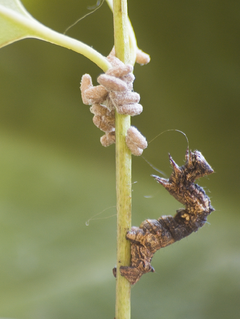Acetobacter is a genus of acetic acid bacteria. Acetic acid bacteria are characterized by the ability to convert ethanol to acetic acid in the presence of oxygen. Of these, the genus Acetobacter is distinguished by the ability to oxidize lactate and acetate into carbon dioxide and water. Bacteria of the genus Acetobacter have been isolated from industrial vinegar fermentation processes and are frequently used as fermentation starter cultures.

Camptosaurus is a genus of plant-eating, beaked ornithischian dinosaurs of the Late Jurassic period of western North America and possibly also Europe. The name means 'flexible lizard'.

Glyptapanteles is a genus of endoparasitoid wasps found in Central and North America and New Zealand. The larvae of the members of Glyptapanteles sp. are distinguished by their ability to manipulate their hosts into serving as bodyguards.
Grimontia hollisae is a species of Grimontia proteobacteria, and is the only pathogenic species that does not grow on thiosulfate-citrate-bile salts-sucrose agar (TCBS). Based on phylogenetic evidence, the species was reclassified in 2003 from Vibrio hollisae.
Virgibacillus is a genus of Gram-positive, rod-shaped (bacillus) bacteria and a member of the phylum Bacillota. Virgibacillus species can be obligate aerobes, or facultative anaerobes and catalase enzyme positive. Under stressful environmental conditions, the bacteria can produce oval or ellipsoidal endospores in terminal, or sometimes subterminal, swollen sporangia. The genus was recently reclassified from the genus Bacillus in 1998 following an analysis of the species V. pantothenticus. Subsequently, a number of new species have been discovered or reclassified as Virgibacillus species.
Microvirgula aerodenitrificans is a species of bacteria, the only species in its genus. It is a Gram-negative, catalase-and oxidase-positive, curved rod-shaped and motile denitrifier. It is aerobic as well as an anoxic heterotroph, having an atypical respiratory type of metabolism in which oxygen and nitrogen oxides are used simultaneously as terminal electron acceptors. SGLY2T is its type strain.
Virgibacillus proomii is a species of Gram-positive bacteria. Strains of this species were originally isolated from soil samples in England and formerly identified as strains of Bacillus pantothenticus. The species is named for British microbiologist Harold Proom.
Aquaspirillum (ak'wă-spī-ril'ŭm) is a genus of helical aerobic bacteria in the family Neisseriaceae that lives in freshwater.
Larkinella is a Gram-negative, chemoorganotrophic and strictly aerobic bacterial genus from the family of Spirosomaceae.
Larkinella insperata is a Gram-negative bacterium from the genus of Larkinella.
Leeuwenhoekiella aequorea is a bacterium from the genus of Leeuwenhoekiella.
Leeuwenhoekiella marinoflava is a bacterium from the genus of Leeuwenhoekiella which has been isolated from seawater from Scotland.
Globicatella sulfidifaciens is a Gram-positive bacteria from the family of Globicatella which has been isolated from the lungs of cattle and lambs in Belgium. It is associated with purulent infections of domestic mammals and urinary tracts of swine. Unlike other Globicatella species and species of related genera, G. sulfidifaciens is PYR negative. Globicatella sulfidifaciens bacteria are resistant against the antibiotics neomycin, erythromycin and clindamycin.
Rhodanobacter spathiphylli is a Gram-negative bacterium from the genus of Rhodanobacter which has been isolated from the root of a Spathiphyllum plant from Leuven in Belgium.
Salegentibacter holothuriorum is a Gram-negative, strictly aerobic and non-motile bacterium from the genus of Salegentibacter which has been isolated from the sea cucumber Apostichopus japonicus from the Sea of Japan.
Ectobacillus is a genus of Gram-positive, rod-shaped bacteria in the family Bacillaceae within the order Bacillales. The type species for this genus is Ectobacillus panaciterrae.
Evansella is a genus of Gram-positive rod-shaped bacteria in the family Bacillaceae within the order Bacillales. The type species for this genus is Evansella cellulosilytica.
Ferdinandcohnia is a genus of rod-shaped bacteria that generally display Gram-positive staining in the family Bacillaceae within the order Bacillales. The type species for this genus is Ferdinandcohnia humi.
Gottfriedia is a genus of Gram-positive or Gram-variable rod-shaped bacteria in the family Bacillaceae within the order Bacillales. The type species for this genus is Gottfriedia luciferensis.

